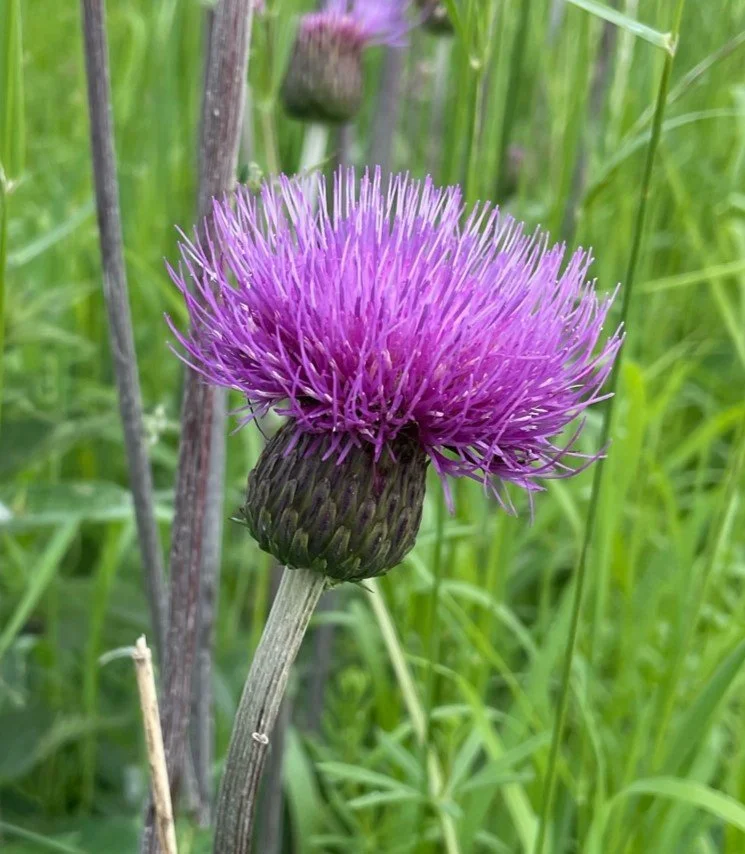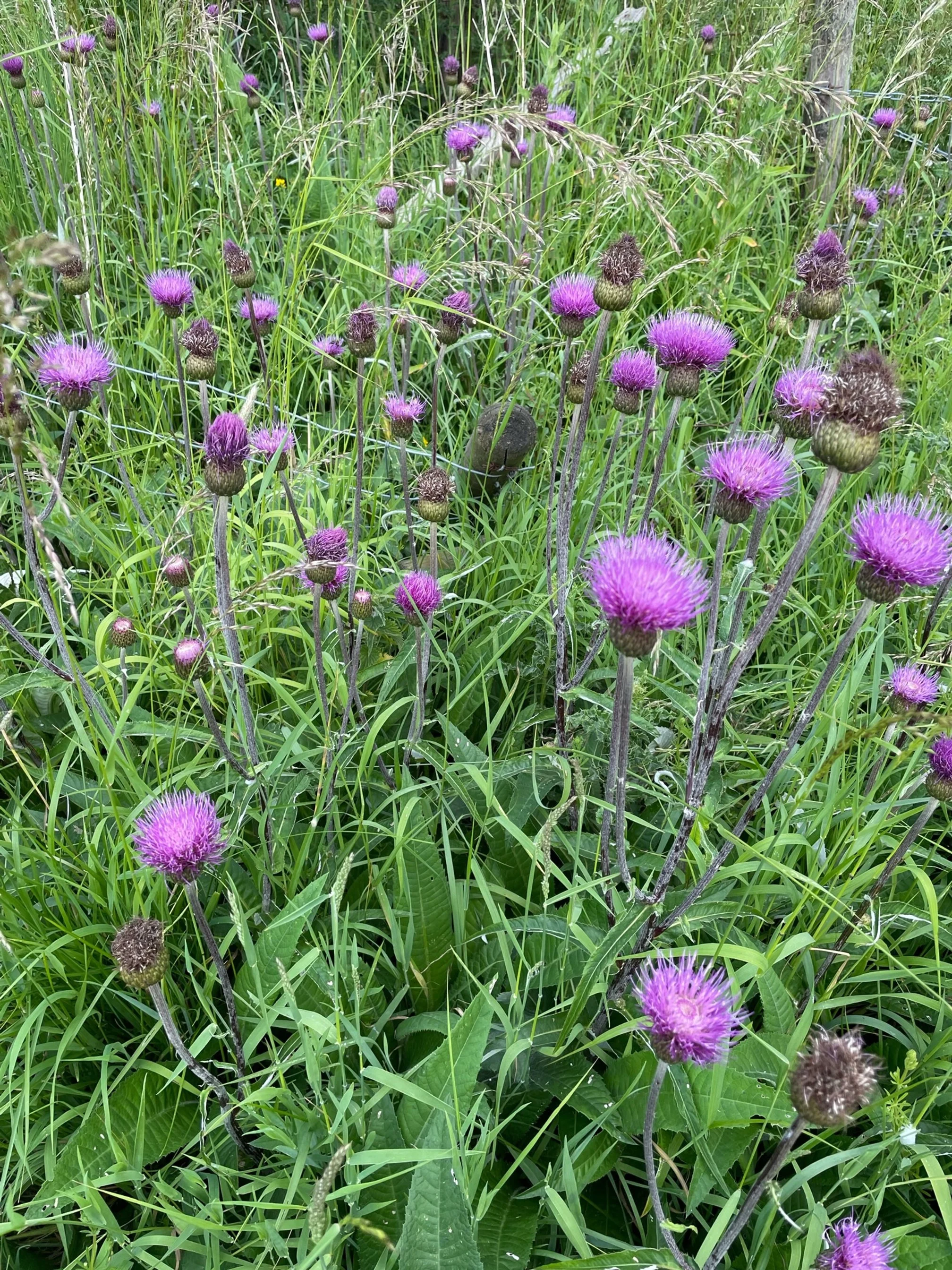#88 Melancholy Thistle by Kay McDowell
Meet Kay McDowell, plant ecologist and vice county recorder!
Kay studied horticulture and garden design and worked as a journalist for Horticulture Week magazine in London for a few years before deciding to spend more time outdoors looking at plants rather than in an office writing about them. Whilst studying and working in horticulture she became interested in naturalistic planting design using native species during visits to the Chelsea Flower Show, and trips abroad to New Zealand, especially the Tongariro National Park on the North Island of New Zealand. She decided that she preferred the dynamism of nature to sometimes quite prescriptive garden design.
She has always been interested in nature and plants, especially plant communities and patterns in nature. She is now a self-employed plant ecologist, working for the North & East Yorkshire Ecological Data Centre as well as River Holme Connections amongst others.
Kay has been joint Vice County Recorder for South-west Yorkshire since 2016 with Louise Hill. She has been a member of the Bradford Botany Group for 20 years and leads South-west Yorkshire Botany Group field meetings.
Kay is married to Neil and enjoys trips to art galleries, dancing and eating Neil’s home-made bread and cakes.
Melancholy Thistle, Kay McDowell
Kay’s chosen species is Melancholy Thistle Cirsium heterophyllum. Melancholy Thistle has handsome red-purple solitary flowers, or rarely 2-3. It is unlike other thistles as it has no spines. The undersides of the leaves are white-felted and the stems are grooved. It is a herbaceous perennial with creeping runners.
There appears to be a number of theories as to where the species got its name; one is because the flowers droop when they are first blooming before gradually standing straight up, or because it usually has single flowers. Following the doctrine of signatures, where a resemblance was often seen between a plant and an ailment, its use might have been indicated by its often single flowers, which in immaturity may tilt to one side. Nicholas Culpepper in his Complete Herbal of 1653 wrote ‘the decoction of the thistle in wine being drank, expels superfluous melancholy out of the body, and makes a man as merry as a cricket...my opinion is, that it is the best remedy against all melancholy diseases.’
Kay vividly remembers seeing this plant for the first time from a minibus window on the way to Kindrogan Field Studies Council centre in Scotland in 2009. It was pointed out to them in a gently sloping grassland by their driver, who was also their tutor, Ben Averis, on the drive from Pitlochry train station.
According to the previous VC63 recorder, Geoffrey Wilmore’s red data list (2012), the species was previously thought to be extinct in VC63 (South-west Yorkshire). It was to our great surprise that Dr Mike Canaway re-found this species in June 2023 in Denshaw, in the Saddleworth district. He recorded about 100 plants after talking to a birder on a walk in the area. The plants were growing next to a beck, which is a typical habitat for the species, as well as damp, usually base-rich unimproved soils such as hay meadows and woodland edges.
Denshaw is in the Saddleworth district, which was part of the historic West Riding of Yorkshire (although this is still a contentious issue for some!) and is now part of Oldham, Greater Manchester. This Cirsium heterophyllum record from Denshaw is possibly the Lees 1888 population. ‘The Flora of West Yorkshire’ by Frederic Arnold Lees (1888), describes Carduus heterophyllus (the species’ previous Latin name) ‘By the Tame Stream below Wragstone Clough, Denshaw’.
Kay plans to update the Flora of Saddleworth with fieldwork starting this year. Who knows what other previously extinct plants may be found in the Saddleworth district?
Patch of Melancholy Thistle, Kay McDowell
This plant is part of the Northern Hay Meadow plant assemblage, which in NVC terms is MG3 – Anthoxanthum odoratum – Geranium sylvaticum grassland. Northern England is a stronghold for upland hay meadows and one of the main concentrations is in the northern Pennines of North Yorkshire. This grassland community occupies less than 1000ha in England, so represents an important and scarce habitat type.
This colourful, herb-rich grassland is of great value for nature conservation. It is home to the uncommon Geranium sylvaticum and Sanguisorba officinalis, and is the main habitat in Great Britain of the scarce Starry Lady’s-mantle (Alchemilla acutiloba), Velvet Lady’s-mantle (A. monticola) and Large-toothed Lady’s-mantle (A. subcrenata) (An Illustrated Guide to British Upland Vegetation, 2004). Other colourful species occurring with melancholy thistle are Marsh Hawk’s-beard (Crepis palusdosa), Wood Crane’s-bill (Geranium sylvaticum), Great Burnet (Sanguisorba officinalis) and Globeflower (Trollius europaeus).
Recording and monitoring
Records of Melancholy Thistle, and other plant species, can be submitted to your VC recorder (which, if you’re recording in VC63, is Kay!). If you are outside VC63, you can find your VC recorder here: Plants.
Further information and acknowledgements
NEYEDC would like to thank Kay for her time and expertise in helping to create this blog.



